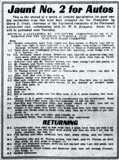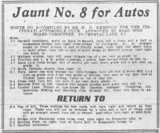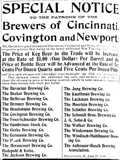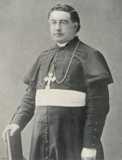
Because lots of Northern Kentucky information doesn't fit neatly into a single county.
The Lexington-Cincinnati Bus
James McBride describes his travels down what is now US 25, in 1810. Read it here.
![]()
 |
 |
|
| You could buy a fine Reo truck at dealers in Covington, Newport, Sanders, Falmouth and Maysville in Kentucky | The origin of the name “3L Highway?” Discovered at last. |
A map of the 3L from 1922. |
| The 3L is better known today as Kentucky Route 17 , from Covington, south, to just north of Falmouth. | ||
![]()
The Kenton County Public Library's Places and Faces: Northern Kentucky Photographic Archive is on line here. They count 110,000+ photo's here. It covers most of the counties of Northern Kentucky Views. |
![]()
The Blizzard of 1978 recorded the lowest barometric pressure ever.
The National Weather Service has lots of pictures at their site on the Blizzard of 1978.
Former WKRC weatherman Scott Dimmich created this page about the horrendous winters of 1977 and 1978. Good stuff. |
|
| The Sponsors of the 1907 Tri-County (Carroll, Gallatin, Owen) Fair in Sanders are listed here. (pdf) 60 Pages of ads from merchants of these three counties, plus Vevay. | “In 1796, part of the cargo of Colonel James Hillman, an experienced trader on the Ohio, consisted of whiskey which was sold to the Indians for $1.00 a quart, the currency of the country, a deer skin being legal tender for a dollar, and a doe skin for half a dollar.” From Gould’s History of River Navigation |
| Charles Kerr’s History of Kentucky, 1922 published a list of all the early settlements in Kentucky. His Northern Kentucky settlements are listed here. | Phone Numbers used to have alpha-prefixes. We grew up in Walton, where our number was Hudson 5-4984. You dialed the first two digits of the exchange (HU) and then the five digits. Other exchange names we've found in Northern Kentucky are here, but there's a bunch we don't have. If we've not listed yours, feel free - please - to Contact Us with it. And our area code? 859? It's for UKY. |
In October of 1926, the Cincinnati Auto Club suggests this route from Cincinnati, through Kenton, Boone, Grant (“not ten acres of level ground in the county”), Pendleton, Campbell and back to Cincinnati. |
The source of the name of the Mary Draper Ingles Highway? If you're not familiar with her story, by all means start here. (pdf) A more expansive story of Ingles is here. (pdf) |
![]()
 |
 |
 |
 |
| These are represented to us as being somewhere in Northern Kentucky. We don't know for sure, but
they are nice shots, and are typical of farming in the area and the period, so here they are. |
|||
![]()
We have here comprehensive lists of every passenger stop on every train that ever went thru Northern Kentucky:
| Kentucky Central | Kentucky Central | Southern (C. N. O. & T. P.) | C&O | Brooksville | |
| Cincinnati south, thru Falmouth to Cynthiana | Lexington to Maysville | Cincinnati-Ludlow-Walton-Williasmtown-Georgetown | Latonia-Walton-Glencoe-Worthville-LaGrange | Vanceburg-Maysville-Augusta-Newport-Cincinnati | Brooksville to Wellsburg |
| now CSX | now CSX | now Norfolk Southern | now CSX | now CSX | now defunct |
A key to some of the abbreviations is here.
A railroad is proposed to run from Brooksville, thru Falmouth and Owenton, to Eminence. Here.
An 1867 tour of the L&N route from Worthville to Covington.
![]()
After the Civil War, Cincinnati merchants wanted urgently to be able to sell goods in the south, but could not match prices from Louisville merchants. Louisville simply had to put things on the L&N, and ship. Cincinnati merchants had to load cargo on a steamer, ship it to Louisville, unload it, and then load it on the L&N. Transportation costs gave Louisville a price break in the South. Long story short: Cincinnati built a railroad; the Southern. The law said the city couldn't buy stock in a railroad, but it didn't say they couldn't build one. The political battle in Kentucky was fierce. The Courier-Journal didn't exactly feel sorry for Cincinnati. They editorialized “Grass will certainly not grow in the streets of Cincinnati in our day. The merchants of Cincinnati, the railroad men of Cincinnati, are a thoroughly live and ingenious set of Yankee plotters, who propose to swarm upon the Southern country like ducks upon June bugs.” Counties not served by the L&N in Kentucky felt differently, so the Kentucky authorities eventually relented, and various lengths of the railroad, offering a variety of passenger and freight services opened from 1887 to 1880. In 1881, the city leased it's holdings to an English corporation controlled by German-born Parisian banker Frédéric Émile d'Erlanger (Wikipedia). The city of Erlanger is named for him. d'Erlanger's CNO&TP holdings eventually end up, in 1894, joining a number of railroads under the name Southern Railway. The City of Cincinnati still owns a 99-year lease on its portion of the Southern (now Norfolk Southern). |
This is Calvin Fairbanks, an UGRR conductor. His story is here.
![]()
UGRR routes into Indiana from various Kentucky locations.
An account of the men of the Underground Railroad from 1900
|
“Beauties of Slavery - a Few days ago, we are told, a man was passing down the Ohio river in a steam boat, having with whom a young, stout, healthy black man whom he called his slave. The black man repeated against being separated from his wife and children and sent to the lower country - the human owner heeded him not, but increased his fetters and threatened him with the lash. The black man, finding entreaties fruit less, threw himself into the river, between Aurora and Rising Sun, and was drowned. We have not heard the name of the white wretch, who is thus guilty of causing the death of this black man.” from the Western Statesman, July 27, 1832. |
|
| Cincinnati Magazine runs a hatchet job on Northern Kentucky, (“not so much Cincinnati's neighbor as its economic dependent”), here. (pdf) | |
| Daniel Drake (Wikipedia) gives us this description of Northern Kentucky from 1815. | There was an 1870 proposal to make a new county out of parts of Boone, Kenton and Gallatin. |
We’ve excerpted portions of John Palmer’s 1818 Journey of Travels in the United States of North America and Lower Canada Performed in the Year 1817. We pick up the journey near Portsmouth Ohio, as he comes down the river past Maysville and Augusta, and follow him into Cincinnati, south to Big Bone, and into Lexington. 1818 makes it pretty interesting stuff in our opinion. It’s a pdf, and it’s here. |
|
| We've excerpted this account (pdf) from Christian Schultz' 1810 Travels on an Inland Voyage. He takes down the Ohio you from well east of Maysville to Louisville. | |
| We've excerpted this account (pdf) from Samuel Cumings' 1848 The Western Pilot: Containing Charts of the Ohio River and of the Mississippi from the Mouth of the Missouri to the Gulf of Mexico. He takes us down the Ohio, with maps, and descriptions of each town on both sides of the river. | A few words from Steve Preston on the early settlement of Cincinnati, of Capt. Byrd's 1780 foray into Kentucky, and George Rogers Clark response are at this site. |
| We've excerpted this account (pdf) from Conclins' 1849 New River Guide, or Gazetteer of All of the Towns on the Western Waters. He, too, takes us down the Ohio, with maps, and descriptions of each town on both sides of the river. | |
| 1861 gun law limited gun ownership. | There were six banks in Northern Kentucky in 1818. It's an odd list. |
| Around 1825, Charles Sealsfield wrote (pdf) of his travels from Cincinnati to Louisville. He passes overland 23 miles to Big Bone, ten miles to his next top at an unnamed location, followed by his third stop fifteen miles later. He crosses the Ohio at Ghent / Vevay. He's very distinctly not impressed by the territory. | |
| The Covington Bishop took the opportunity to give some history and a current evaluation of Catholicism in North Kentucky. | |
| In 1884, Prof. G. Frederick Wright published his Theory of A Glacial Dam in Cincinnati / Northern Kentucky (pdf). | “Gallatin, Trimble, Owen, and Carroll counties combines as a Union Agricultural Society in 1838, and three fairs are of record.” Farms and Fair Makers of Kentucky, a WPA document |
| A list of country officials from 1801-1804 is here (pdf). Keep in mind at this time, only Boone, Bracken, Campbell, Gallatin, and Pendleton had been established; other counties would be carved from these in time. | German Catholics versus Irish Catholics, a critical distinction in 19th century America, discussed here. |
| Oh-these-kids-today department: “In all the schools of the period . . .when the master had taken his seat, the boys were required, on entering the door, to take take off their hats and make a bow - the girls to curtesy. . . .It was further inculcated on them to take off their hats and bow and curtsey to all whom they met, either coming or going. . . .This was that cultivation of reverence and good manners which, fifty years afterward, I find so ominously neglected.” Daniel Drake, in Pioneer Life in Kentucky, which was written c. 1870. | |
| An Indian episode from somewhere along the Licking in 1787. In that year, everything east of the Licking was Bourbon County. | |
| A nifty little tool at the web site of the Minneapolis Federal Reserve will convert old prices (1913 and later) into current prices. Try it here. | In 1856-1857, the Kentucky Geologic Survey equivalent published surveys of various Kentucky counties. The one covering Kenton, Campbell and Pendleton is here (pdf). The one covering Owen, Gallatin, Grant, and Boone is here. (pdf) Three counties had separate documents - Bracken, Mason, and Trimble. (all pdf's) |
| The Negro Motorist Green Book (Wikipedia) was a travel guide of friendly stops for African-American travelers. We looked thru a number of years, and found but these two listings in 1960 in Northern Kentucky. | |
Covington, Newport and Cincinnati collude to set beer prices, 1897.
From a Facebook post by Tammy Cornett, from the Cincinnati Enquirer, June 28 1897
 |
 |
 |
| Just as the newspapers run (ran?) TV listings, in the 1940's they ran listings of radio shows. The samples here are a random Saturday, Sunday and Monday from the Enquirer in January, 1940. | ||
![]()
| Northern Kentucky high schools which have won the state boys basketball championship: | |||
| Corinth, 1930; | Brooksville, 1939; | Maysville, 1947; | Simon Kenton, 1981 |
More recent winners include teams from Mason County and Covington Catholic.
![]()
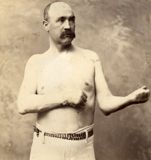 |
 |
| Tom Allen | Joe Goss |
| In 1877, the two boxers vying for the Heavyweight Championship of the World fought in Independence (first seven rounds), Walton (final rounds), and some seedier spectators were deliberately sent to Worthville, Sanders, and Sparta on purpose, where they wreaked havoc on the populace. More here. More on Goss here. | |
![]()
![]()
 |
 |
 |
| Arcaro and Citation, after winning the Kentucky Derby |
Arcaro and Citation on the home stretch at the Derby |
Arcaro on Whirlaway |
Arcaro won the Triple Crown in 1941 on Whirlaway and again in 1948 on Citation.
He's the only man to win the Triple Crown twice.
|
 |
 |
 |
|
| Eddie Arcaro (February 19, 1916 – November 14, 1997) was one of America's greatest jockeys. He was born in Cincinnati, but raised in Covington and Newport, rode at Latonia, and later owned a bar in Erlanger (110 Dixie Highway). You can read his Wikipedia entry here. | ||||
![]()
|
“From general observation, when we consider the natural feeling of a white man that is born and reared in the State of Ohio, regarding the rights and privileges due our race, especially if he is engaged in business in Kentucky, or an employee, his greatest aim is to stir animosity and impede the Negro. But the Kentuckian will assist the Negro, and you can find him what he professes to be. A hint should be sufficient.”from Indianapolis' The Freeman, A National Illustrated Colored Newspaper, August 9, 1890 |
![]()
| The August 17, 1837 Kentucky Gazette listed a number of postal routes in the state, including this one: "3232. From Maysville by Dover, Minerva, Germantown, Power's X Roads, Falmouth, Grassy Creek, and Fishburg [likely a typo (Fiskburg)], to Gaines X Roads [Walton], 69 miles and back, twice a week." |
![]()
The first masthead of the two merged Northern Kentucky newspapers, The Kentucky Post, and
The Kentucky Times-Star. Both were special Kentucky editions of Cincinnati newspapers.
![]()
| A reporter traveled the newly opened railroad from Louisville to Covington in 1867, and describes the territory from Worthville to Covington, here. | Dr. Alvin Poweleit compiled some information he called Our Northern Kentucky Negro Doctors. You can read it here. (pdf) | Eugene Druley's Early Telephone History of Northern Kentucky can be found here. (pdf) |
| Krysta Wilham writes on the Spanish Flue epidemic of 1918-1919 - it killed over 8,000 people locally - at this site. | ||
Daniel Boone State Park, 15 miles south of Covington. Huh? Everything we know about it is here. |
Ulysses S. Grant passed from Louisville to Cincinnati in 1879, His train schedule, showing every little town he came through, is here. It's 2 years after his Presidency, and they still call him General Grant. | A Warsaw man shoots a Williamstown man in a Falmouth disorderly house, here. |
| If you were in the Kentucky militia in 1816, here's where you go to get paid. | The eight men of Northern Kentucky who have been US Senators. | |
There's a site where you can look up who in your county is putting the most noxious pollutants into your air, here. |
George F. Roth Jr. wrote about Early Architecture in the Covington-Newport Area of Kentucky, and you can read it here. (pdf) | Lafayette came through Northern Kentucky. Read about it, here. |
| Contemporary pictures of the equipment of Northern Kentucky Fire Departments, are at this site. | ||
Hog Cholera an issue at distilleries in Carroll, Gallatin and Mason in 1857, here. |
Civil war solder A. C. Dicken, C.S.A., kept a diary in his service days, the Northern Kentucky portion of which you can read here. (pdf) | Wm. Lytle travels from Maysville to Louisville in 1780. Encounters Indians. Story's here. |
| Col. Richard Johnson (Wikipedia) calls his militia from Henry, Gallatin, Boone, Campbell, Pendleton, Bracken and Mason. Since Grant, Carroll, Trimble, and Kenton didn't yet exist, it's essentially all of Northern Kentucky, to join him in the War of 1812. Read it here. | Early, c. 1816, description of Covington and Newport, here. | |
| William O'Neal's The Stagecoach Comes to Northern Kentucky is here. (pdf) | Mr. Ellis Cummins Crawford's paper on Notes and Diaries of Early Kentucky Settlers is here. (pdf) | William Strategier's History of Railroads in Kentucky, here. (pdf) |
| The word “Methodist” comes from John and Charles Wesley following their own methods for worship, and not those of the then Catholic establishment. They were also called “Supererogation-men,” “Enthusiasts,” “The Holy Club,” and “Bible Moths.” “Methodists” is just the name that stuck. | The Kentucky Post takes a stab at predicting the future in 1928. Nail it. Here. | |
A description of the mail route, in 1833, that ran from Washington, in Mason County, to Big Bone Lick, in Boone, here. |
A site that has posted a lot of older high school yearbooks of Kentucky schools is here. They invite your scans. | In 1882, Karl Kron rode his bicycle from Covington to Lexington. Read about his adventure here. |
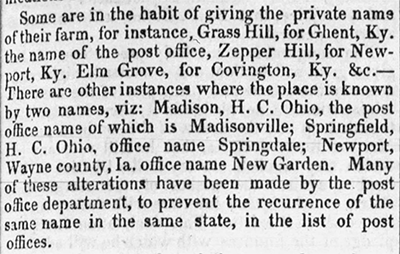
Niles Register, March 18 , 1837
| The Kentucky Tribune ran these stories, mostly by Dr. Paul Tenkotte, of Northern Kentucky fast food restaurants, along with a couple of Cincinnati outliers. | |
| Frisch's | Chili Parlors |
| Izzy's | White Castle |
| McDonald's | Jerry's |
| Wendy's | Lunch Wagons |
| Pure Food/Temperance | Dixie Chili |
In 1905, President Theodore Roosevelt's train moves from Cincinnati to Louisville by the above timetable.
![]()
There are a bunch of sketches of various Northern Kentucky places on our pages that were drawings by Burlington's Caroline Williams, who published her sketches in the Enquirer for decades. A little more about her is in this profile from 1939. |
![]()
![]()
Read about the Kentucky Tobacco Wars here.
The New York Times version is here.
![]()
| Dr. Joseph Gastright's History of the Kentucky Central Railroad is in three parts: (pdf's) | ||
| Part 1 | Part 2 | Part 3 |
![]()
Why has the bank name on this check has been crossed out? You'll find it hard to believe.
![]()
Excepting only the 1937 flood, there hasn't been a natural disaster to affect Northern Kentucky to match the tornados of July 7, 1915. See the stories and pictures here. |
![]()
There's a 312 page book called Biographical Memoirs of the Covington & Newport Commanderies,
which lists biographies of Masonic Knight's Templars in those cities, from 1878. All 312 pages are
on line at the UK Special Locations Library;
search for it by its title.
![]()
Speaking of bicycles, the League of
American Wheelman, a bike club, in 1912 published guide books of routes |
||||
| from Newport to Alexandria and Fort Thomas, here. | an alternate route from Newport to Alexandria, here. | from Covington to Falmouth is here. | from Covington to Burlington is here. | from Cincinnati to Lawrenceburg, thru Kentucky, is here. |
Read about the 1906 bike race from Lexington to Covington. The winner did it in 6 hours and 8 minutes.
![]()
| This is a post office. When you read of post offices in the 19th and early 20th centuries, don't think of buildings; think of furniture. Post offices used to be highly politicized, and could move from location to location based on who supported whom in the last election. This example, from Pleasant Hill's Shakertown, is typical, if not a little larger than, most PO's of the day. |
![]()
“Within the past few days a number of slaves, from this State, have
escaped into Ohio, and are now on their way to Canada, via the
underground railroad. Four of the slaves belonged to Harvey
Williamson, of Union County; five belonged to Joseph Harris, of
Bracken county, and two owned in Boone county. They came to
Cincinnati, by taking passage on a float down the Licking river, and
thence to a point half a mile below Sedamsville [across from
Ludlow], where, by the aid of friends, they got off to Canada.” From the Louisville Daily Courier, April 20,
1855 |
| “The Cassopolis Outrage” occurred in Michigan in 1847, when 30 heavily armed men tried to take a number escaped slaves. It occurred in Cassopolis, Michigan, and you can read more about it at this site. See also this interview (pdf), with Perry Sandford, a slave from Boone and later Kenton Counties, who escaped to Michigan, and spoke of the Cassopolis affair. |
| Henry Clay attempted to reconcile two Methodist Church factions in 1845. He failed, and the church split into the pro-slavery Methodist Church South, and the anti-slavery Methodist Church North. |
| Every now and then you come across some idiot who wants to talk about how slavery wasn't really the evil that it's portrayed as. To those folks, we dedicate this document (pdf). It's not for the squeamish. |
| “A fugitive from Kentucky declared years later, that his own master had been captain of a reserve corps of men over forty-five years of age, organized after the outbreak of the War of 1812 to aid in slave police duty, and that 'at that time there were many colored people joined in a conspiracy to get their freedom, and wore as a mark a plait in the hair over the left eye. This was discovered - many were whipped, and had the plait cut off. The conspiracy extended over three hundred miles, from Maysville to Henderson.“ from American Negro Slave Revolts, by Herbert Aptheker, 1943. As always, take all slave revolt stories with a grain of salt; they frequently contain more paranoia than fact. |
![]()
On September 23, 1905, Covington's Henry Gadker, of 499 Pike Street, was arrested for manufacturing . . . oleomargarine? Yup. In those days, making margarine was illegal. It was considered a form of fraud to add yellow coloring to the naturally white-ish margarine. You can read more at Wikipedia's page on margarine here. (In other news, Wikipedia has a page about margarine?!?!? Talk about information Age overload . . .) |
Lustron houses (Wikipedia) are prefabricated enameled steel houses developed in the post-World War II era United States in response to the shortage of houses for returning GIs. You can find one in Alexandria, two in Edgewood, one in Fort Wright, and three in Owenton. Several more have been torn down. We're intentionally not posting the addresses - these are, after all, still peoples' homes - but if you nose around a little on Google . . . |
![]()
Military posts - and we use the term loosely - were established at various points in Kentucky in 1791 in anticipation of 1792 statehood.
![]()
Richard Sears and Alvah C. Roebuck founded the company, but it was Julius Rosenwald who made it a national powerhouse. Like Andrew Carnegie, he gave away huge amounts of his fortune, most notably by building schools for Afro-American children. There were six Rosenwald schools in Northern Kentucky: (all links Wikipedia) |
| a two-teacher school in Carrollton (1926); a one teacher school on Park Ridge in Gallatin Co. (1923); a one-teacher school in Dry Ridge (1924); a four-teacher school in Mayslick (1920); a one-teacher school in Washington (1926), and; a one-teacher school in Owen Co.'s New Liberty (1923). |
![]()
| If you spend much time looking at Northern Kentucky history, you will absolutely come across the Rev. Bishop Camillus Paul Maes, March 13, 1846 – May 11, 1915. He was the Bishop of the Covington Diocese from 1885 until his death in 1915. The Catholic Telegraph's profile of him is here, and his Wikipedia page is here. |
| Thomas Campbell | Alexander Campbell | Barton Stone |
| The Rev. Thomas Campbell had a seminary in Burlington in 1808, but otherwise these men never lived in Northern Kentucky. Rather, they started the Protestant Restoration (Wikipedia). In an era when people had theological reasons for which church they attended, the teachings of these men would cause upheaval in many Northern Kentucky Churches. Read more about Thomas Campbell, the church he founded, and the movement he began, here. Read about his Burlington experience here. |
![]()
"It is quit the fashion for persons who belong to older generations to sing the praises of “the good old days.” And to bemoan the customs, manners and morals of the present. Such persons are particularly fond of describing the joys of their youth and of insisting that young people of today are most unfortunate because they miss a great many of the delightful experiences of childhood which were enjoyed by earlier generations. Most of this is sentimental nonsense. But when older persons describe the experiences which have lingered so pleasantly in their memories – when they relate the joys of trudging miles down a country road to school, of chopping wood in the barn lot, of thawing out the pump, of taking their baths in a wash-tub in the kitchen, of old-fashioned toilet facilities, of filling kerosene lamps, of putting hot flat-irons in their beds to keep their feet warm, and of “hitching old Dobbin to the shay” – when they tell of these experiences and then insist that life in those days was more enjoyable than it is now with all our modern conveniences; that simply does not make sense.” W. D. Funkhauser, in The Days That Are Gone. |
| “Only in recent years have historians generally come to recognize that the mere recording of the activities of rulers, of wars and their consequences, is a shallow and deplorably inadequate record of the past.” Emmet Field Horine, in his preface to Pioneer Life in Kentucky. |
. . . but Wendell Berry expressed it more eloquently.
![]()

